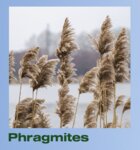

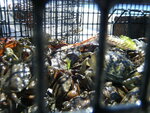

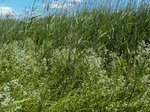
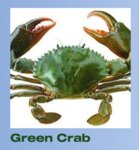
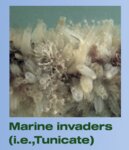

MOST PEOPLE OBSERVE the Great Marsh from a boat or a marsh-transecting roadway or a home.
From these vantage points, all looks picturesque and natural, as one imagines a healthy salt marsh estuary ecosystem should look. But as one hones in on the details of the marsh vegetation, one may see a different condition, a condition all too familiar to scientists and conservationists. As the climate changes and waters warm, the marsh is under attack from a new opportunistic set of invaders that are now just beginning to impact the processes of the marsh.
However, not all these problems are new; as long as 100 years ago human activities have made their mark on the marsh both physically and functionally.
Currently, invasive phragmites, perennial pepperweed, green crabs, and other marine invasive animals and plants have a strong foothold into the Great Marsh. The Great Marsh Partnership has been working for over a decade to help manage and control these estuarine villains.
Phragmites australis, or common reed, was one of the first major invasives that the Partnership tackled. One day while working the salt marsh on an unrelated project (Kayaker’s Guide to the Great Marsh) we noticed a prolific number of small newly emerging stands and stems of Phragmites in the open, high marsh, far from any marsh upland edge. Phragmites is extremely common along the marsh/upland edge where the freshwater groundwater merges with the saltwater of the marsh, diluting it to the point where a highly adaptable Phragmites plant can grow in the slightly brackish waters. However, this Phragmites genotype is somewhat self-limited and generally does not grow out into the saltmarsh too far as it cannot tolerate the high salinities away from the groundwater influence.
We have always known about many of the larger Phragmites stands that are growing out in the middle of the marsh on the high marsh platform but assumed they were stable and not expanding, until we began our efforts on the Kayakers Guide.
That’s when we noticed they were, in fact, enlarging. We immediately began mapping the extent, and maturity of these open, high marsh stands to better understand the emerging problem. Under the guidance of the Great Marsh legislative delegation, the Great Marsh Revitalization Task Force was created. Through the Task Force, which includes nonprofit property owners, federal agencies, state agencies, university researchers, sportsman groups, and municipalities, the Partnership was able to obtain funding to do what had not been attempted at such a scale in Massachusetts, which was to research the problem and remove hundreds of large and small stands of invasive Phragmites from the saltmarsh.
To identify how to best control this invasive plant we tested various management methods, everything from fire, cutting stands down, drowning them in salt water, or controlled chemical applications. After evaluating the relative effectiveness of these approaches, the Partnership settled on measured chemical control and undertook this management approach in conjunction with the U.S. Fish and Wildlife Service at Parker River National Wildlife Refuge. Contractors used a “marshmaster” (a very low ground pressure tracked vehicle that also floats to enable it to cross creeks and can traverse the broad marsh quickly) for the larger Phragmites stands and backpack applicators to treat the more inaccessible and smaller emerging stands.
The open marsh Phragmites were dominant in the northern area of the Great Marsh, in the Newbury, Newburyport, Rowley, and Salisbury coastal marshes, behind the barrier beaches of Plum Island and Salisbury. The federal government funded a large-scale hydrodynamic modeling study to identify if there was an impact of the Plum Island Turnpike River crossing, which in the early 1970’s created a tidal restriction when the new bridge was built, reducing the opening from several hundred feet to about 50 feet.
Would this restriction so constrict the saltwater from entering into the Newbury mashes and let the water to become more brackish to allow Phragmites to thrive? Or did it restrict the freshwater from the Merrimack River from entering the salt marshes which would be better for native vegetation?
Results and hopes of enlarging the bridge opening to allow more saltwater through were not verified by the model, thus it was determined that controlling Phragmites through saltwater influx here would not be successful. Chemical treatment was concluded to be the best management practice as well as the most cost-effective, but it was carefully restricted to stand by stand and stem by stem application to minimize any residual environmental spread. After several diligent years of control and management, with guidance from the members of the Great Marsh Revitalization Task Force, the Partnership can claim success. Our monitoring program indicates that native salt marsh vegetation replaces the treated Phragmites within the first growing season. As well, there are no large stands left in the open marsh of any of the communities previously infested with Phragmites. Now all that is required is backpack spray maintenance treatments every other year or so to keep new Phragmites sprouts in check. Many of the functions of a diverse, healthy and functioning saltmarsh have returned to this section of the Great Marsh.
There is another extensive effort to control a relatively new Great Marsh invader. That being the perennial pepperweed plant.
Perennial pepperweed is not as aggressive as Phragmites in the Great Marsh but could be if not for the efforts of the MassAudubon and the Parker River National Wildlife Refuge to manage it over the last 10 years.
It is suspected that this invasive may have entered the Great Marsh via the Merrimack River where it is much more common in the inland freshwater environment. In the salt marsh, perennial pepperweed takes up residence at the higher edge of the marsh adjacent to the upland, marsh island edges, or even on the fringes of mosquito ditches where the ditch spoils were discarded in the WPA days of the 1930s.
Hundreds of volunteers (including school groups, nonprofit members, property owners, and government officials) have come together over the years every late spring to help control the expansion of the plant by physically pulling the plant up by its roots.
In smaller patches where the plant grows this work is a very effective management practice. In larger and/or more remote areas where pepperweed grows and volunteers cannot gain access, pepperweed, like Phragmites, is treated with very specific low-dose chemical. The work of the Pepper “WEED WARRIORS” has been tremendous and those efforts, which started in the Great Marsh, are now being copied in Maine, New Hampshire, and Rhode Island as well as many other coastal marshes of Massachusetts.
European green crab has been in the waters of the Great Marsh for many, many years. Most of us have seen them at the beach, in the marshes, in the creeks, and from our boats. They are often green, but can range from orange to blue to whitish and are generally about two to three inches across the shell at midlife. They have been periodically raising havoc with the softshell clam industry for over one hundred years, as most recent as last year and in 2016.
Spearheaded by funding from local legislators, a bounty on green crab has been in place for several years to reduce their numbers; 40 cents per pound is paid to trappers in several of the participating communities in the Great Marsh to trap and dispose of green crab outside the coastal system. It appears to be working; however, winter climate may also play a role in how prolific the green crabs may be in the following summer.
Over the last several years, the Great Marsh Partnership has been working to create a demand for the crustacean in hopes that market-driven forces will reduce their numbers.
Attempts in the culinary field to develop a softshell green crab and a green crab she-crab soup were unsuccessful as neither is profitable or would reduce their numbers significantly. Also, the development of a green crab fertilizer has not yet been found to be sustainable, but that one we are still working on one. At 180,00 green crab babies per female per year, we will certainly need a more concerted effort at control.
Rounding out the dominant “big four” coastal invasives in the Great Marsh is the marine invader category. This group includes dozens of invasive plants and animals that have moved into the Great Marsh coastal ecosystem from all over the world. They originally came in the ballast water of ships, but increasingly they are moving up the coast with the warming waters of climate change. With unpronounceable Latin names, they can be very common to the boater or fisherman who finds their lines and docks fouled with tunicates, bryozoans, crustaceans, anemones, bivalves, and seaweeds.
The Great Marsh Partnership monitors several docks in the Great Marsh, but that’s all we can do. There is no easy (or difficult) fix, thus, as with all species residing in the saltmarsh ecosystem (especially the invasive ones), we continue to monitor and watch and see what other creatures and invaders are moving our way.
Peter Phippen is a hydrogeologist and coastal scientist with 40 years of experience in water resources management. He is currently coordinator of the Eight Towns and the Great Marsh Committee, a division of the MassBays National Estuary Partnership and Merrimack Valley Planning.